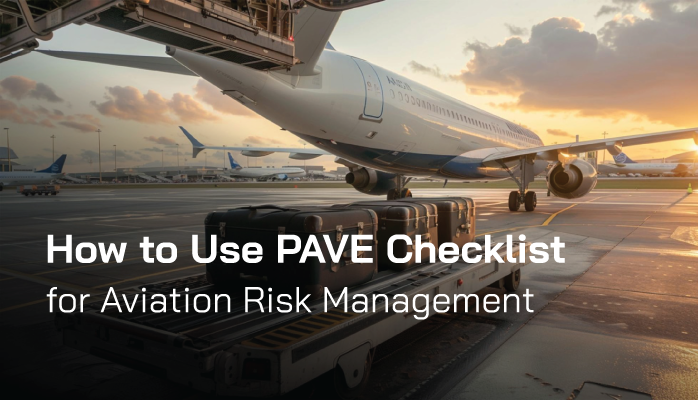Understanding Proactive Hazard Analysis Process

The best way to recognize and mitigate immediate risks associated with aviation hazards is by using the PAVE checklist to analyze your current safety environment. PAVE is an excellent and expedient flight risk assessment tool (FRAT).
Each risk scenario can be grouped under a part of the PAVE checklist and can help with recognizing both the hazard and the need to react for a particular mission. The need to react may be one of your control measures identified during the proactive hazard analysis process.
When your company subject-matter experts undertake the hazard identification process, a list of credible risk scenarios is generated. For each risk scenario, subject-matter experts must also identify the existing control measures, which may fall under these types:
- Preventive;
- Detective; and
- Corrective.
Related Articles on Aviation SMS Risk Controls
- Difference between Hazards, Risks & Control Measures in Aviation SMS
- What Is a Risk Control in Aviation SMS: Meaning, Purpose, Application
- How to Monitor the Effectiveness of Control Measures
How to Use PAVE for Individual Flight Risk Management
Risk management strategies referred to above are designed for the aviation service provider as a whole. There are also risk management strategies that each pilot should use before each mission.
The PAVE checklist is an exceptional tool for identifying hazards and mitigating risk. While some companies use detailed flight risk assessment tools (FRAT), it is clear that FRAT is not ubiquitous. Upper-level management may not like to adopt time-consuming FRATs because it may cut into pilots' flight-duty time.
Let's look at how a student explains PAVE to us:
"P" stands for pilot.
You are at the beginning of the checklist because if you are not fit to fly, then the rest of the checklist needs not to be addressed.
80% of all accidents are pilot errors, while not necessarily all of those are due to the pilot not being fit or qualified for the flight, it definitely contributes. If you are wondering whether you are in the right situation to fly there’s another checklist called "IM SAFE."
IM SAFE is a proactive way to evaluate your health before flying. "I" stands for illness, are you sick? "M" stands for medication; have you taken any? If so is it still legal for you to be flying? "S" stands for sleep; have you gotten your full requirement? "A" stands for alcohol, ensure you are following all the regulations that apply to consumption. "F" stands for fatigue; have you flown already? How long? Are you still alert enough to continue? "E" stands for eating. Food is your fuel, without it, you will not function properly either and may want to shut down for good.
Also make sure that you haven’t developed what is called "get home it is," this affects many pilots and can be the first step down a road of safety problems.
When it comes to seeing whether you are qualified to make a flight, it is important to make your own personal list of limitations. This way you can plan ahead for situations that make you question your ability and refer to the list to answer your question in black and white.
"A" in the PAVE checklist stands for the airplane.
It is important that you are familiar with equipment capabilities and that the flight planned does not exceed those. A proactive mindset to have when looking at this is to become familiar with your airplane’s POH, and constantly monitor your aircraft’s performance so that you can adequately judge what it can do.
"V" stands for environment.
This includes weather, one of the largest risks to flying there.
It also includes terrain, applicable NOTAMs, and whether or not the flight will be made at night. These elements place an extensive burden on preflight planning and judgment. Sometimes the proactive decision here is the decision to not go if, for example, your course has squall lines across it.
"E" stands for external pressures.
Management of the risks that come from external pressures is the most important of the checklist. This is because external pressures are what can cause a pilot to ignore all the other risks.
A CEO who insists we need to get there tonight doesn’t understand how much of a hazard this is to the flight. Your job is not really to fly the plane, although that is important--your real job is to make the right decisions.
Be firm when saying no to clients or management, especially if the risks are not manageable.
Related Aviation Risk Management Articles
- Difference between Reactive, Predictive and Proactive Risk Management in Aviation SMS
- How to Practice Reactive, Proactive, and Predictive Risk Management in Aviation SMS
- 8 Stages of Safety Events in Aviation Risk Management Programs
Frequent Practice Hones Flight Risk Management Skills
In conclusion, there is a lot that goes into risk management and the best way to get good is to always practice good habits. This way, if you ever get into real trouble the right actions will seem like second nature.
All of these concepts combined contribute to the proactive mindset that is needed to have a successful flight and thoroughly understand and perform risk management.
If you want to review other tools, check out the following free flight risk assessment tools.
FRAT checklists are also valuable if you don't have Internet access during your pre-flight checks.
Last updated October 2023.






